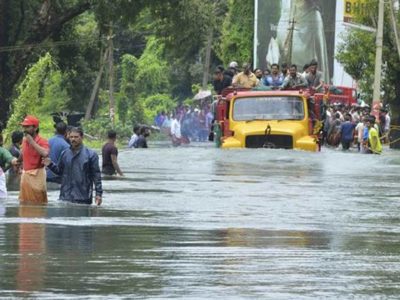Another Dam Climate Adaptation Problem
Report Suggests That Poor Management Intensified Kerala Flood Devastation
 The Economic and Political Weekly is one of India’s most prestigious journals: for decades it has enjoyed a unique role in driving the Union’s policy conversation, partly because it is peer-reviewed. And this week, it contains a devastating report about how poor dam management exacerbated Kerala’s horrific floods.
The Economic and Political Weekly is one of India’s most prestigious journals: for decades it has enjoyed a unique role in driving the Union’s policy conversation, partly because it is peer-reviewed. And this week, it contains a devastating report about how poor dam management exacerbated Kerala’s horrific floods.
It’s an obvious issue: if dams have too much water in them when floods occur they can’t serve as storage for floodwaters, and they might be topped or even breached as the floodwaters rise. Perhaps most importantly, if dams are properly managed, they don’t have to release as much water during a flood, allowing downstream rivers to absorb more capacity. But according to Himanshu Thakkar the coordinator of the South Asia Network on Dams, Rivers and People in Delhi, improper management foreclosed the option of dams absorbing more — with ghastly results.
This isn’t just an issue for India hands like me, or even those concerned about the appalling loss of life and property in Kerala. Unless our dam management keeps up with latest climate forecasts, all of us could face similar or related impacts because plans will be outdated.
Central to Thakkar’s critique is the “rule curve,” or “how the dam is supposed to be filled during the monsoon to optimise flood moderation for the downstream areas, while ensuring that it is filled up only towards the end of the monsoon.” Although the Central Water Commission tried to sweep the problem under the rug, Thakkar notes that all the technical information and reports necessary to update a rule curve and prepare for flooding was nonexistent:
[E]ach state has to prepare a dam operation manual for each large dam that also includes an emergency action plan (EAP). Here, emergency does not only refer to the event of a dam break, but to all kind of crises. The EAP also requires determination of potential inundation area, preparation of inundation maps and notification of emergency, setting up of a hydrological unit for preparation of inundation map, and setting up of an emergency control room for each dam to coordinate crisis situation. None of the Kerala dams had all of these: no manuals, EAPs, or even inundation maps.
To be fair, this disaster was the worst the state had faced in a century. But there were warnings, and as late as late July, before the disaster of August occurred, there were plenty of opportunities to adjust the water behind Kerala’s dams (such as the great Idduki Dam, pictured at the head of the article). No one, however, followed them. It is easy to look back in hindsight, but we push proper planning in order not to be surprised by these events. Thakkar argues with a lot of evidence that with proper management, the Idukki Dam’s outflow could have been reduced by two-thirds, leaving far more capacity for downstream rivers to absorb the flood.
We hope, of course, that all of America’s dams are properly prepared. But are they, especially under an administration that detests technical competence and rejects climate science? Who is minding the store aside from industry lobbyists?






Reader Comments